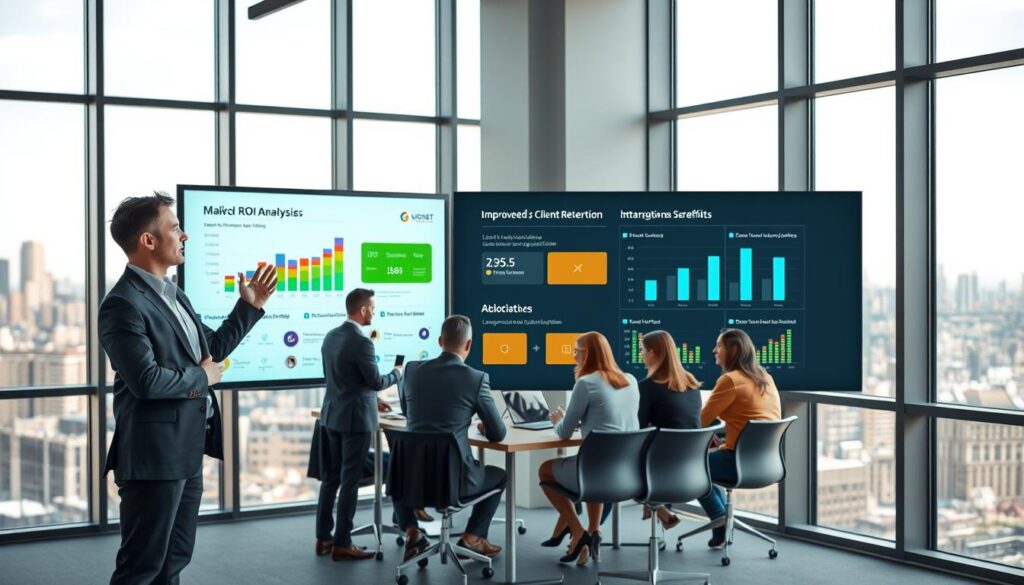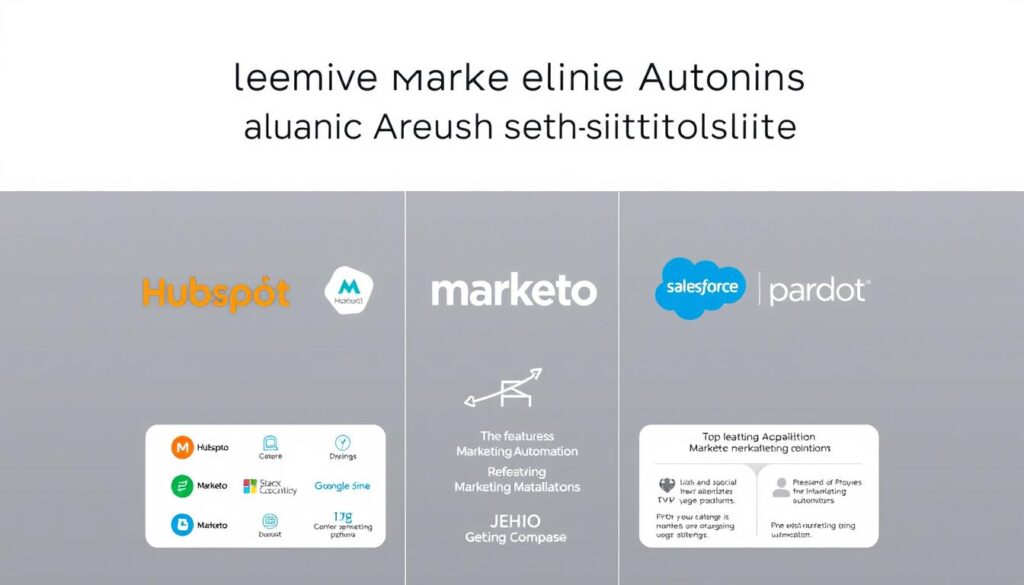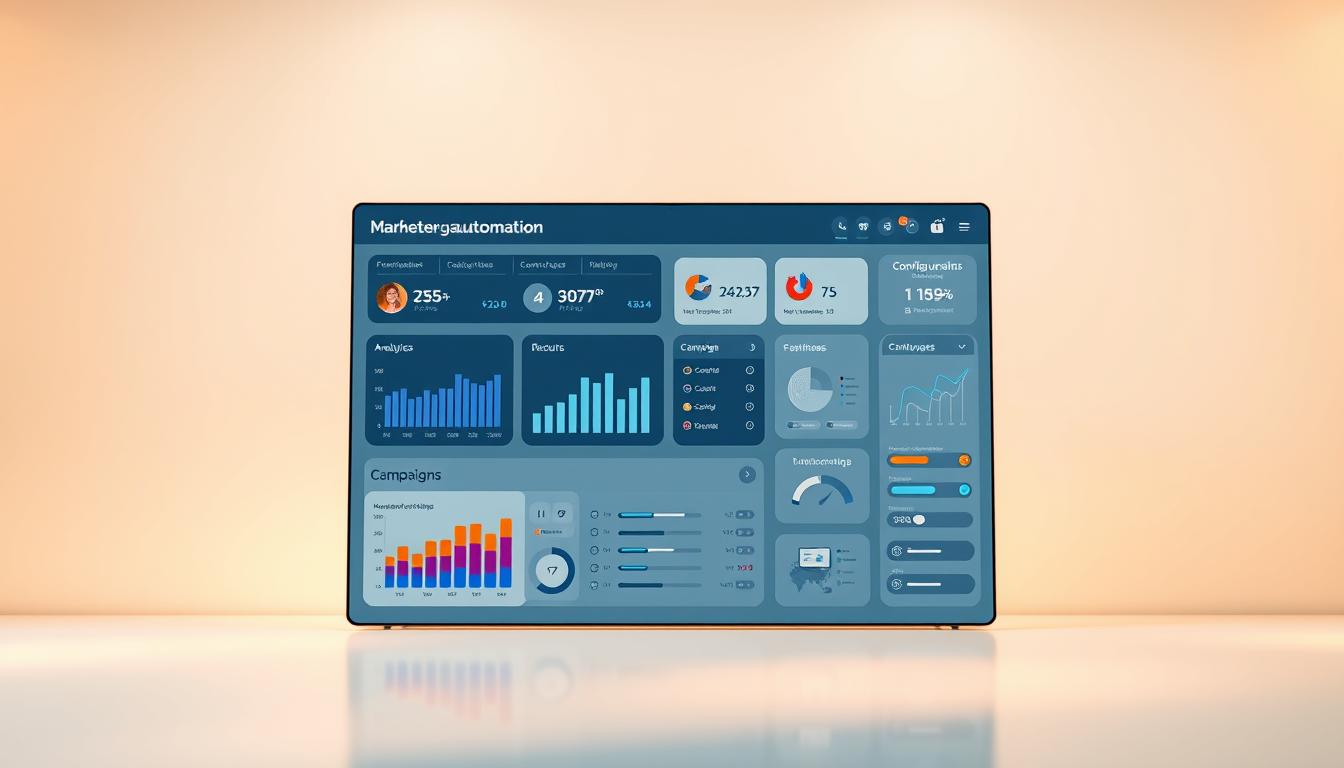The world of professional service marketing has changed a lot. Firms that used to rely on word of mouth and old-school networking now face tough competition online. To succeed, you need more than just your skills.
Companies using marketing automation professional services are seeing big wins. They get 451% more qualified leads by using these tools. These business automation tools take care of boring tasks like following up with leads. This lets you focus on doing your best work.
This guide will show you how to turn your practice into a growth machine. You’ll learn how to get more clients and grow your business. We’ll give you steps to make your clients happy and save your time and resources.
Key Takeaways
- Businesses using automation generate 451% more qualified leads than traditional methods
- Professional services require specialized automation approaches different from product-based marketing
- Automation streamlines client acquisition, relationship nurturing, and operational scaling
- 2025 demands automation as a competitive necessity, not a luxury for service providers
- Proper implementation maximizes time efficiency while enriching client experiences
- This guide provides actionable strategies and real-world examples for immediate implementation
Understanding Marketing Automation for Professional Services
Marketing automation is key for service-based businesses. It’s different from selling products because it builds trust and shows expertise. It’s not about making quick sales.
Running a professional service firm means you’re selling knowledge and experience. Clients can’t easily judge these before they buy.
What Marketing Automation Means for Service-Based Businesses
For professional services, marketing automation creates workflows that guide prospects. It shows your thought leadership and builds credibility over time.
These tools offer personalized experiences based on where prospects are in their journey. You can send content, case studies, and insights that show your value.

Key Differences from Product-Based Marketing Automation
Service-based business marketing needs longer nurturing cycles than product sales. Prospects need time to see your expertise and trust your abilities.
Product marketing focuses on features and benefits. But, professional services marketing is about relationships and outcomes. Your workflows should focus on education, not just promotion.
Current Market Trends and ROI Statistics for 2025
Recent marketing automation research shows great results for professional services firms. Companies using automation get 451% more qualified leads than those without.
| Industry Sector | Lead Increase | ROI Per Dollar | Client Acquisition Rate |
|---|---|---|---|
| Law Firm Marketing | 380% | $38 | 75% |
| Accounting Services | 420% | $45 | 82% |
| Consulting Firms | 510% | $42 | 78% |
| Financial Advisory | 465% | $40 | 80% |
The data shows that 80% of professional services firms using automation see better client acquisition rates. Email automation, in particular, offers an average return of $42 for every dollar invested. It’s essential for managing client touchpoints effectively.
Benefits of Implementing Marketing Automation in Professional Services
Marketing automation brings big changes to how professional services grow and operate. It helps you save time and gives you a competitive edge. You’ll see how it improves your business in many ways.
Studies show that using marketing automation can lead to 451% more qualified leads. This is because it sends out consistent, targeted messages. These messages build trust with clients as they move through the buying process.

Streamlined Lead Nurturing and Client Onboarding
Your lead nurturing process gets a lot easier with automation. Automated drip campaigns send out valuable content at the right time. This is great for accounting firm leads who need to learn before they decide.
Onboarding new clients becomes smooth and professional. They get welcome messages, document requests, and clear expectations automatically. This shows your expertise right from the start.
Enhanced Client Retention and Relationship Management
Client retention automation makes sure you never lose touch with clients. It sends out reminders, value-added content, and check-ins automatically. This keeps your communication consistent without needing to do it all by hand.
Managing relationships gets better with regular, automated touchpoints. You can send out birthday messages, anniversary greetings, and industry updates. This shows clients you care about their success.
Improved ROI and Time Management for Busy Professionals
Your professional services ROI will go up a lot when you automate routine tasks. You can focus on important work like strategy and client meetings. This means less time on paperwork and more time on what matters.
“Marketing automation allows professionals to work on their business, not just in their business.”
Scalability Solutions for Growing Practices
Automation makes it easier to grow without adding more staff. You can handle more clients without sacrificing quality. This opens up new opportunities for growth and profit.
| Benefit Category | Manual Process | Automated Process | Time Savings |
|---|---|---|---|
| Lead Follow-up | 2 hours daily | 15 minutes setup | 85% reduction |
| Client Check-ins | 3 hours weekly | 30 minutes monthly | 90% reduction |
| Proposal Delivery | 1 hour per proposal | 5 minutes per proposal | 92% reduction |
Essential Marketing Automation Tools and Platform Selection
Professional services firms face unique challenges when choosing marketing automation platforms. Unlike product-based businesses, they need tools for complex client relationships and longer sales cycles. The right platform is key to nurturing prospects and keeping client connections strong.
Your success hinges on picking solutions that fit your workflows. Think about your team’s skills and growth plans when making these decisions.

CRM Integration Solutions for Professional Services
CRM integration tools are vital for effective automation. Your platform must work well with systems like Salesforce, HubSpot, or Pipedrive. This ensures client data moves smoothly between marketing and sales.
Choose platforms that keep data consistent across all touchpoints. Real-time syncing prevents duplicate entries and keeps your team on the same page with client interactions.
Email Marketing Automation Platforms Comparison
Platform capabilities vary based on your needs and budget. Basic options like Mailchimp are good for simple campaigns under $100 monthly. But, for advanced consulting automation, you need more powerful solutions.
| Platform | Monthly Cost | Best For | Key Features |
|---|---|---|---|
| Mailchimp | $10-$300 | Small practices | Basic automation, templates |
| ActiveCampaign | $29-$229 | Growing firms | Advanced segmentation, CRM |
| HubSpot | $45-$3,200 | Full-service needs | Complete marketing suite |
| Marketo | $895-$3,195 | Enterprise B2B | Complex lead scoring |
Social Media Management and Scheduling Tools
Social media tools should support your email efforts by showing your expertise. Platforms like Buffer or Hootsuite help keep your professional presence consistent. Choose tools that integrate with your marketing automation platforms for unified reporting.
Analytics and Reporting Software Requirements
Your analytics platform must track lead sources, conversion rates, and client lifetime value. Look for solutions that provide clear ROI metrics and actionable insights. CRM integration tools should offer detailed dashboards showing the client journey from start to retention.
The best platform is one your team will use regularly. Prioritize ease of use alongside powerful features for the best consulting automation results.
Step 1: Setting Up Your Marketing Automation Foundation
Your marketing foundation is key to getting quality leads or wasting resources. Strategic planning here prevents mistakes and helps your business grow. Professional services need a different strategy than product businesses, focusing on building trust and relationships.
“The foundation of successful marketing automation lies not in the technology, but in understanding your clients’ journey and delivering value at every touchpoint.”
How to Define Your Ideal Client Personas
Creating client personas is more than just demographics. It includes their decision-making and pain points. Your personas should show the complexity of professional services buying decisions. Multiple stakeholders often influence these decisions, requiring extended evaluation periods.
Document their communication styles, budget ranges, and common objections. Also, note their research habits and information sources. This helps you create content that speaks to specific client types.
Mapping the Professional Services Client Journey
The client journey for professional services has seven stages: awareness, research, evaluation, proposal, decision, onboarding, and advocacy. Each stage needs specific content and touchpoints to build trust and show expertise.
Unlike product purchases, service evaluations have complex approval processes. Your journey map should reflect longer decision cycles and multiple touchpoints. Focus on being a trusted advisor instead of just a vendor.
Creating Content Frameworks and Templates
Make templates for welcome sequences, educational newsletters, and proposal follow-ups. These frameworks ensure consistency and save time across different areas. Law firm marketing, for example, needs compliance-focused messaging that’s different from consulting.
Your content should educate prospects about industry challenges and solutions. Create templates that can be customized for different services while keeping your brand voice and expertise.
Establishing Measurable Key Performance Indicators
Professional services KPIs are different from e-commerce metrics. Track lead generation, email engagement, consultation booking, and proposal acceptance rates. Client lifetime value is key for measuring long-term success.
Set realistic benchmarks based on industry standards and plan for improvement. Your KPIs should match your business goals and give insights for optimization.
Step 2: Building Effective Email Marketing Campaigns
Creating strategic email sequences changes how firms connect with clients. Your email marketing campaigns should educate and build trust. They should show your expertise, not just push sales.
This method builds lasting relationships. It drives sustainable business growth.
Creating Welcome Series for New Prospects
Your welcome sequence is key for long-term client relationships. Start with a welcome email that introduces your firm’s expertise and values. Then, share relevant case studies and educational resources over 7-14 days.
Include social proof and testimonials to quickly build credibility. Gradually introduce your main services while providing immediate value. This approach helps turn accounting firm leads and other prospects into engaged clients.
Developing Educational Newsletter Sequences
Be seen as a thought leader by sharing educational content. Share industry insights, updates, and best practices. This helps prospects solve problems before they become clients.
Segment your newsletter content by practice areas and client size. Deliver targeted information that addresses specific daily challenges your audience faces.
Setting Up Follow-up Campaigns for Consultations
Automate your consultation process to keep momentum. Send pre-consultation emails with questions and background materials. Follow up with consultation summaries and next steps within 24 hours.
Create automated proposal follow-ups that address common concerns. This approach significantly improves conversion rates from consultation to signed contract.
Implementing Client Retention Email Strategies
Keep clients engaged to maximize lifetime value and get referrals. Send regular check-ins, industry updates, and service reminders. Client retention strategies should include quarterly business reviews and proactive communication about regulatory changes.
Automate referral requests after successful projects. Use segmentation to deliver personalized content that reflects each client’s specific needs and engagement history with your firm.
Step 3: Implementing Lead Generation and Nurturing Systems
To build strong lead generation systems, you need smart automation. This automation works all the time to find and help your ideal clients. It turns random interactions into steady income.
Your firm needs consistent processes. These should bring in qualified leads even when you’re busy with clients.
Good automation stops the ups and downs many businesses face. You’ll set up steps that help prospects make decisions, typical in professional services. The goal is to have touchpoints that work well together.
Content Marketing Automation Workflows
Content marketing workflows are key to attracting and keeping leads. Set up automated series that send valuable content based on what prospects are interested in. For example, after someone downloads a whitepaper, send them related case studies and insights.
Make your workflows specific to different areas or challenges. This makes your content more relevant and boosts engagement by 40%. Your lead generation process will be more effective when prospects get content that solves their problems.
Webinar and Event Follow-up Automation
Use automation to get the most from speaking and events. Send out materials before the event and then follow up with more content and conversations. This keeps leads engaged after the event.
Studies show that 80% of webinar leads are lost due to poor follow-up. Automation makes sure everyone gets the right next steps based on how they interacted with your presentation.
Referral Program Automation Setup
Make client referrals a steady source of leads with consulting automation. Send out referral requests at the right times, like after a project is done. Send thank-you messages and rewards automatically to make it easy for clients to refer others.
Keep track of where referrals come from and how they do. This helps you focus on building relationships with clients who are likely to refer more.
Social Proof and Testimonial Collection Systems
Collect testimonials and case studies automatically. Ask for feedback at key times, like after a successful project. Your system should get specific details about what was achieved and challenges overcome.
Automate collecting online reviews too. This boosts your credibility and supports your marketing without much effort from your team.
Marketing Automation Professional Services Implementation Guide
Professional services firms need a clear implementation guide to use marketing automation well. This guide helps you set up systems that improve client relationships, not just replace personal service.
Your marketing automation setup success comes from following tested steps. These steps match your firm’s growth and goals. Each step builds on the last, creating a strong base for success.
Phase 1: Planning and Strategy Development Process
This first phase lasts 4-6 weeks and focuses on setting goals before starting any technical work. You’ll set clear goals, map out the client journey, and decide on success metrics that matter to your firm.
Involve key people in this phase to make sure everyone knows the automation goals. Resource allocation and timeline establishment help avoid costly errors. This planning helps you avoid automating things that don’t work well.
Phase 2: Tool Selection and Technical Setup
Evaluating platforms takes 6-8 weeks. You’ll pick tools that fit your technical skills and budget. Your consulting automation platform should work well with your current systems.
Setting up tech includes linking your CRM, making email templates, and setting up basic workflows. Many firms get help from outside experts during this phase to ensure it’s done right.
Phase 3: Content Creation and Campaign Building
This creative phase lasts 8-10 weeks. You’ll create messages that show your expertise and brand voice. You’ll make content calendars, email sequences, landing pages, and lead magnets to engage prospects.
Getting your whole team involved in content creation helps keep things consistent and real. This phase needs teamwork but is key to getting results.
Phase 4: Testing, Launch, and Initial Optimization
Start by launching simple campaigns and then add more complexity. This ongoing phase is about testing, watching how things perform, and making improvements based on data.
Success in implementation means being patient and open to making changes based on results. Start small, measure everything, and grow your automation as you learn and get more confident.
Industry-Specific Automation Strategies and Best Practices
Marketing automation in professional services must tackle unique challenges. This includes legal ethics and healthcare privacy. Each sector has its own rules, client needs, and business models. These all need customized automation approaches.
You can’t use the same strategy for all professional service industries. Success comes from knowing your sector’s needs and tailoring your automation.
Law Firm Implementation
Law firm marketing automation must follow ethical rules and protect client privacy. Make sure all automated messages meet bar association rules and keep professional standards.
Automate intake, case updates, and educational content. But, keep personal touches for sensitive matters and client talks. Segment prospects by practice area for targeted messaging.
Automate scheduling and document collection, but always have a human check confidential messages.
Accounting Firm Lead Generation
Accounting firm leads benefit from seasonal automation. This matches tax deadlines and regulatory changes. Automate reminders, quarterly updates, and educational content on new rules.
A Sydney accounting firm saw a 45% increase in new clients with automated tax tips. This builds trust and shows expertise.
Automatically qualify leads by business size, complexity, and service needs. This ensures efficient use of resources.
Consulting Workflows and Management
Consulting automation aims to show thought leadership and expertise. Automate follow-ups, updates, and knowledge sharing to keep clients engaged.
Create workflows for long-term relationships and repeat business. Be seen as a trusted advisor through consistent, valuable communication.
“The key to successful consulting automation is balancing efficiency with the personal touch that clients expect from high-level advisory services.”
Healthcare and Financial Services Requirements
Compliance considerations are key in regulated industries like healthcare and finance. Your automation must meet HIPAA, SOX, or other rules.
Use proper consent, encryption, and audit trails. Regular compliance reviews and staff training are vital. This ensures your automation meets professional obligations.
Always put data security and client privacy first in these sectors.
Step 4: Measuring Success and Optimizing Performance
Tracking the right performance metrics turns your marketing automation into a money maker. It’s all about linking every touchpoint to outcomes that show your investment is worth it.
Professional services firms need to show how automation adds value. They must track both signs of future success and actual results.
Essential Metrics to Track for Professional Services
Focus on three key areas for your success. Lead generation metrics include marketing qualified leads, cost per acquisition, and conversion rates.
Email marketing needs constant watch. Professional services should aim for 18-22% open rates and 2-4% click-through rates. Unsubscribe rates above 2% mean you need to adjust your content or send frequency.
Client retention metrics show long-term value. Track lifetime value, repeat engagement rates, and Net Promoter Scores. These help accounting firm leads and others see how happy their clients are.
A/B Testing Strategies for Email and Content
Testing improves your campaigns. Try different subject lines, send times, content types, and call-to-action spots to increase engagement.
Professional services should test content types. See how educational versus promotional content works for your audience. Also, test formal versus casual tones to find what your audience likes best.
ROI Calculation Methods and Benchmarks
Calculate total costs of automation, including software, setup, and ongoing content. Compare these to increased revenue, time saved, and efficiency gains.
ROI calculation methods aim for 3:1 to 5:1 returns for automation in professional services. This ensures growth and justifies ongoing investment.
Continuous Improvement and Optimization Processes
Regular reviews keep your performance high. Monthly reviews find quick wins, and quarterly ones guide big changes.
Use data to improve targeting and content quality. Expand winning campaigns and cut losing ones to get the most from your automation.
Common Implementation Pitfalls and How to Avoid Them
Knowing about implementation pitfalls helps you create systems that improve client relationships. Professional service firms often face common challenges that can harm their plans. By learning from these mistakes, you can save time, money, and keep client trust.
Success means finding a balance between efficiency and personal touch. Your automation should make human connections better, not replace them.
Over-Automation Mistakes That Damage Client Relationships
The biggest error is automating interactions that should be personal. Never automate sensitive communications, crisis responses, or high-value sales conversations. Clients want human interaction during important calls, negotiations, and problem solving.
Keep a clear line between automated and personal interactions. Use automation for reminders, educational content, and routine follow-ups. Save human interaction for complex talks and building relationships.
Compliance and Privacy Issues in Professional Services
Automation in professional services must follow strict rules and protect data. Make sure your systems keep client information safe, store data securely, and communicate ethically.
Use proper consent methods and keep detailed records. Law firm marketing automation needs extra care for attorney-client privilege and bar association rules. Regular checks prevent big problems.
Integration Challenges and Technical Solutions
System integration problems often come from linking automation platforms with existing software. Plan for data migration, compatibility, and workflow issues during setup.
Get help from tech experts when needed and keep backup systems ready. Test all integrations well before going live.
Staff Training and Adoption Strategies
Good staff training strategies are key to automation success. Offer full system training, clear processes, and accountability for your team.
Deal with change resistance by educating about benefits and involving in system choice. Regular training keeps your team using automation well while keeping service quality high.
Conclusion
The marketing automation field is growing fast. Industry projections show the market will hit $18.45 billion by. Automation consulting helps 61% of companies see real results.
This guide has given you the tools to change your practice. The digital shift in professional services is ongoing. Companies that move now will get ahead by improving client ties and making operations smoother.
Begin with a small step today. Pick one automation workflow from this guide and start it in the next 30 days. Starting with email nurturing or lead scoring is a good start. Each step moves you closer to full automation.
Your clients want modern service. Marketing automation services help you deliver this while freeing up time for what you do best. The tools and strategies shared here are real and used by top practices globally.
Being an early adopter gives you an edge. While others hesitate, you can win over clients with better experiences and efficiency. Investing in automation now will shape your success tomorrow.

